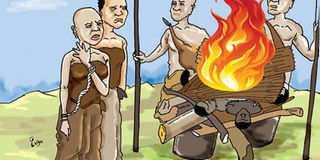Women in evangelism and the unsung female martyrs

Teaching a lesson. An illustration of women looking on as male martyrs are burnt alive on the orders of Kabaka Mwanga. ILLUSTRATIONS BY IVAN SENYONJO
What you need to know:
Female martyrs. Female martyrs included Maria Matilda Munaku and Valeria Mmeeme, sister and mother respectively of Noah Mawagali. They were not executed like Mawagali, but tortured and consequently died from their injuries, writes Henry Lubega.
It is that time of the year again that focus is turned to the Uganda martyrs. Officially, there are 45 martyrs; 23 Anglicans and 22 Catholics. But little or no attention is paid to the female martyrs.
Women in evangelism
The acknowledgment of women’s marginalisation in the Church first emerged in 1794, way before the coming of Christianity to Uganda. The female inequality found itself taking a hold as Christianity spread in Uganda.
In her 1851 publication Ain’t I a Woman, Sojourner Truth talked about the issue of women having limited rights due to men’s flawed perception of women.
More than a decade after the coming of Christianity to Uganda, the role of female missionaries was discussed during the May 13, 1892 Church Council.
According to Louis Pirouet’s Black Evangelists: The Spread of Christianity in Uganda 1891-1914: “The Church Council discussed the need for work among women because it had become impossible for the men to handle women’s issues in the absence of female missionaries.”
Despite that realisation, the first woman to attend theological school, Florence Njangali, was not spared of discrimination. She joined Bishop Tucker Theological seminary in 1942 and trained as a catechist.
According to Rev Canon Dr Rebecca Margaret Nyegenye, “Florence Njangali was not allowed to enter class with men, but sat outside on the veranda and listened through the window. She managed to finish her course and was posted as a commissioned worker while her male counterparts were ordained.”
First converts
The first recorded converts to Christianity in Uganda were predominantly men. In the Catholic Church, there was no woman, while the first group of Anglicans to be baptised included two women: Princesses Clara (Kalaala) Nalumansi, the elder sister of Kabaka Mwanga, and Lakeri Namikka, the daughter of Kabaka Ssuuna.
At the time of her death, Nalumansi had converted to Catholicism on the orders of her brother the Kabaka.
The early concentration of missionaries in the courts explains why the first converts were in court service and whey they made up the bulk of the martyrs. This is not, however, to say that the common people outside the royal courts were excluded from religious instruction.
There were women converts baptised in the early 1880s besides the two princesses. These included Rachael Sebuliba, Malyamu Mukasa, Sara Nakima, Fanny Mubulire, Ketula, Princess Rebecca Magali, and Doti.
Among these women, Sebuliba and three others at the peak of the sleeping sickness outbreak on lake Victoria Islands decided to go and spread the gospel there when other evangelists where afraid.
She returned to the islands in 1903 during which she contracted the disease. On her death bed at Mengo Hospital, she said: “My body hurts me very much but my spirit rejoices.”
Earlier, Mwanga had killed many converts, now celebrated as martyrs. According to a 1976 publication, Obulamu bw’Abajulizi by Msgr Timoteo M. Ssemwogerere, female converts were not killed like the rest of the martyrs.
“Kabaka Mwanga ordered for the killing of men, he barred his men from killing women,” Ssemwogerere writes.
However, Fr Joseph Ddiba in the 1955 edition of Eddini mu Uganda talks of Mwanga’s intention of sparing women believers, but having them witness the executions.
“Mwanga thought that if women watched their husbands and brothers being killed it will stop them from following the new religion,” he wrote.

Many of the female martyrs were not executed like their male counterparts, but were tortured and died as a result of their injuries.
During the execution of the first three martyrs – Joseph Lugalama, Mako (Mark) Kakumba and Noah Serwanga on January 31, 1885 – a woman called Sarah Nakaima Nalwanga who had been arrested with them, was spared but made to witness how chief executioner Mudalasi burnt the three boys.
This was in the hope that she would be deterred from following her new faith. Other reports, however, claim it was because she was found with child that she survived execution.
Female martyrs
Female martyrs included Maria Matilda Munaku and Valeria Mmeeme, sister and mother respectively of Noah Mawagali. They were not executed like Mawagali, but tortured and consequently died from their injuries.
Kikuvambuga, the wife of Matia Mulumba, was arrested during the purge of Christians by the group led by Mbugano that went to Mityana looking for Christians.
At the time of her arrest, Mulumba had already been killed at Old Kampala. She was not executed, but the torture she was subjected to eventually lead to her death.
According to Msgr Ssemwogerere’s Obulamu bw’Abajulizi first edition he says, “Musubika from Minyinya Catholic Parish in Masaka is a real martyr and Rome is yet to look into her martyrdom.”
Ssemwogerere also talks of Sesilia Nalusiba from Bisanje Catholic Parish, also from Masaka Diocese, as another of the female martyrs.
The latest addition to the list of women martyrs is Angelina Lyaka from Tororo in eastern Uganda, killed in 1927.
Msgr Ssemwogerere in his book says few female martyrs are mentioned and are yet to be recognised by the Church officially.
“There are women who died for Jesus Christ but the Pope has not been furnished with the details of their death in faith. We should pray for their miracles so that the Pope canonises them.”
Background
A sizeable number of the 45 male martyrs were said to have had families. It was suspected that their families too had converted to Christianity. Those widowed during the tumultuous years of the killing of martyrs included Fanny Mubulire. Her husband, Fredrick Kizza, was one of the Anglican martyrs killed at Nakiyanjja on June 3, 1886.




